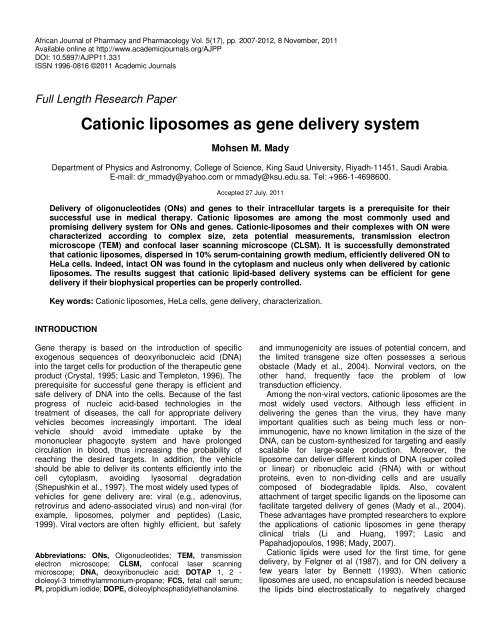Download Complete Issue (3090kb) - Academic Journals
Download Complete Issue (3090kb) - Academic Journals
Download Complete Issue (3090kb) - Academic Journals
You also want an ePaper? Increase the reach of your titles
YUMPU automatically turns print PDFs into web optimized ePapers that Google loves.
African Journal of Pharmacy and Pharmacology Vol. 5(17), pp. 2007-2012, 8 November, 2011<br />
Available online at http://www.academicjournals.org/AJPP<br />
DOI: 10.5897/AJPP11.331<br />
ISSN 1996-0816 ©2011 <strong>Academic</strong> <strong>Journals</strong><br />
Full Length Research Paper<br />
Cationic liposomes as gene delivery system<br />
Mohsen M. Mady<br />
Department of Physics and Astronomy, College of Science, King Saud University, Riyadh-11451, Saudi Arabia.<br />
E-mail: dr_mmady@yahoo.com or mmady@ksu.edu.sa. Tel: +966-1-4698600.<br />
Accepted 27 July, 2011<br />
Delivery of oligonucleotides (ONs) and genes to their intracellular targets is a prerequisite for their<br />
successful use in medical therapy. Cationic liposomes are among the most commonly used and<br />
promising delivery system for ONs and genes. Cationic-liposomes and their complexes with ON were<br />
characterized according to complex size, zeta potential measurements, transmission electron<br />
microscope (TEM) and confocal laser scanning microscope (CLSM). It is successfully demonstrated<br />
that cationic liposomes, dispersed in 10% serum-containing growth medium, efficiently delivered ON to<br />
HeLa cells. Indeed, intact ON was found in the cytoplasm and nucleus only when delivered by cationic<br />
liposomes. The results suggest that cationic lipid-based delivery systems can be efficient for gene<br />
delivery if their biophysical properties can be properly controlled.<br />
Key words: Cationic liposomes, HeLa cells, gene delivery, characterization.<br />
INTRODUCTION<br />
Gene therapy is based on the introduction of specific<br />
exogenous sequences of deoxyribonucleic acid (DNA)<br />
into the target cells for production of the therapeutic gene<br />
product (Crystal, 1995; Lasic and Templeton, 1996). The<br />
prerequisite for successful gene therapy is efficient and<br />
safe delivery of DNA into the cells. Because of the fast<br />
progress of nucleic acid-based technologies in the<br />
treatment of diseases, the call for appropriate delivery<br />
vehicles becomes increasingly important. The ideal<br />
vehicle should avoid immediate uptake by the<br />
mononuclear phagocyte system and have prolonged<br />
circulation in blood, thus increasing the probability of<br />
reaching the desired targets. In addition, the vehicle<br />
should be able to deliver its contents efficiently into the<br />
cell cytoplasm, avoiding lysosomal degradation<br />
(Shepushkin et al., 1997). The most widely used types of<br />
vehicles for gene delivery are: viral (e.g., adenovirus,<br />
retrovirus and adeno-associated virus) and non-viral (for<br />
example, liposomes, polymer and peptides) (Lasic,<br />
1999). Viral vectors are often highly efficient, but safety<br />
Abbreviations: ONs, Oligonucleotides; TEM, transmission<br />
electron microscope; CLSM, confocal laser scanning<br />
microscope; DNA, deoxyribonucleic acid; DOTAP 1, 2 -<br />
dioleoyl-3 trimethylammonium-propane; FCS, fetal calf serum;<br />
PI, propidium iodide; DOPE, dioleoylphosphatidylethanolamine.<br />
and immunogenicity are issues of potential concern, and<br />
the limited transgene size often possesses a serious<br />
obstacle (Mady et al., 2004). Nonviral vectors, on the<br />
other hand, frequently face the problem of low<br />
transduction efficiency.<br />
Among the non-viral vectors, cationic liposomes are the<br />
most widely used vectors. Although less efficient in<br />
delivering the genes than the virus, they have many<br />
important qualities such as being much less or nonimmunogenic,<br />
have no known limitation in the size of the<br />
DNA, can be custom-synthesized for targeting and easily<br />
scalable for large-scale production. Moreover, the<br />
liposome can deliver different kinds of DNA (super coiled<br />
or linear) or ribonucleic acid (RNA) with or without<br />
proteins, even to non-dividing cells and are usually<br />
composed of biodegradable lipids. Also, covalent<br />
attachment of target specific ligands on the liposome can<br />
facilitate targeted delivery of genes (Mady et al., 2004).<br />
These advantages have prompted researchers to explore<br />
the applications of cationic liposomes in gene therapy<br />
clinical trials (Li and Huang, 1997; Lasic and<br />
Papahadjopoulos, 1998; Mady, 2007).<br />
Cationic lipids were used for the first time, for gene<br />
delivery, by Felgner et al (1987), and for ON delivery a<br />
few years later by Bennett (1993). When cationic<br />
liposomes are used, no encapsulation is needed because<br />
the lipids bind electrostatically to negatively charged

















